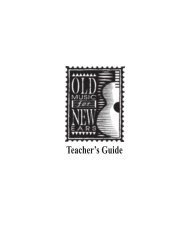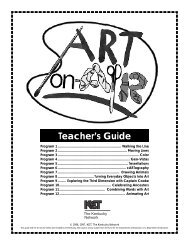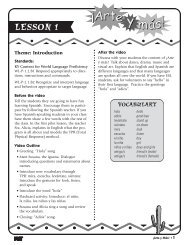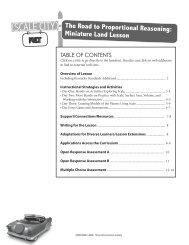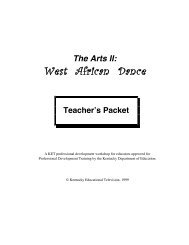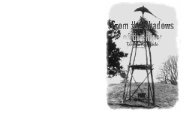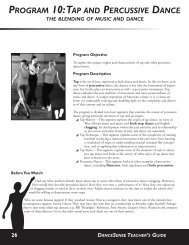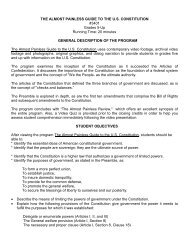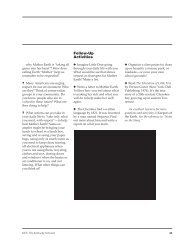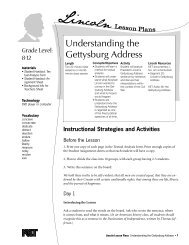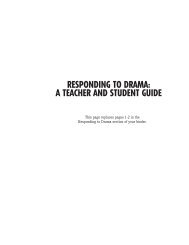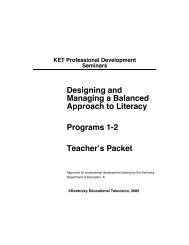MUSIC! - KET
MUSIC! - KET
MUSIC! - KET
Create successful ePaper yourself
Turn your PDF publications into a flip-book with our unique Google optimized e-Paper software.
An Amazing Year<br />
By Garlene Layne-Abshire, Johns Creek School, Pike County<br />
The 2006-2007 school year<br />
began as a difficult one for me<br />
and my family. On May 22,<br />
2006, my 16-year-old son Dustin<br />
had a terrible four-wheeler accident<br />
that changed our lives.<br />
Dustin received massive skull<br />
fractures and traumatic brain<br />
injury. By the time school began<br />
that August his condition was<br />
improving, but he was still hospitalized<br />
at the Cardinal Hill<br />
Rehabilitation Hospital in<br />
Lexington.<br />
This was the beginning of my<br />
12th year of teaching. I was an<br />
itinerant teacher at two schools,<br />
teaching K-8 in my certification area of visual art. After<br />
Dustin’s accident, while he was in a coma and we had no<br />
way of knowing the future, I asked to be stationed at<br />
only one school so that when Dustin returned home I<br />
would be close to him when needed. When I received my<br />
letter of placement, I was surprised that I had been<br />
transferred to Johns Creek Elementary. This was returning<br />
home for me; Johns Creek is the school where I<br />
attended first grade through graduation from high<br />
school. (When I was a student, Johns Creek was a K-12<br />
school; currently it houses preschool through 8th grade.)<br />
Garlene and her son Dustin<br />
Good News and a New Challenge<br />
When school started I would come home from Lexington<br />
on Sunday evenings and stay through Thursday<br />
evenings. After 158 days away from home, 39 days on life<br />
support, and seven weeks in a deep coma (it was 75 days<br />
before he said his first word), Dustin was released from<br />
the hospital on September 28. He came home and is now<br />
in his senior year at Pike County Central.<br />
On my first day at Johns Creek, I had been informed<br />
that I would only be teaching fifth grade. I would not<br />
only be teaching my beloved visual art but would also be<br />
teaching drama and dance. I was in shock! I had no clue<br />
as to how to go about teaching these areas of the Core<br />
Content to 84 young, absorbent minds. Even though the<br />
previous year I had attained my National Board<br />
Certification in Early Adolescence Through Young<br />
Adulthood in Art and I am currently president of the<br />
Pike County Arts Council, I was still terrified. My wonderful<br />
(younger than me) principal assured me that I<br />
would have no problem with this. I was happy that he<br />
felt that way; however, deep down inside I was scared to<br />
death to know that I had so much to prepare for, especially<br />
since this was on the CATS TEST!<br />
After doing research on the Web and not<br />
being happy with all the confusing<br />
things out there, I began questioning my<br />
colleagues as to what I should do. The<br />
one thing that kept being repeated was<br />
to “use the <strong>KET</strong> toolkits.” I have a great<br />
friend who is employed by <strong>KET</strong>, Cynthia<br />
Warner (education consultant for<br />
Eastern Kentucky). She also suggested<br />
the toolkits and all the vast materials<br />
that they offered. So I took the Dance<br />
and Drama kits home and pored over<br />
them for many hours.<br />
Combining the toolkits with other materials,<br />
in January I began my units of<br />
study in these areas. We have a wonderful<br />
music teacher with whom I collaborated,<br />
making these studies more thorough and bringing more<br />
enrichment to students in both our classes.<br />
Using DanceSense<br />
I began our dance studies with the first four programs<br />
of the 10-part DanceSense series that is included in the<br />
Dance Toolkit. These are excellent programs that I<br />
adapted slightly. Along with the programs, the students<br />
used the glossary and the DVD video clips that greatly<br />
reinforced our studies.<br />
The first program helped ease the students into understanding<br />
how everyday movements can be turned into<br />
dance movements. The boys especially loved the clip<br />
showing how football movements can be turned into<br />
dance movements! Several got up and actually demonstrated<br />
those movements for us.<br />
In Program Two (evolution of dance from European to<br />
modern social dance), students explored the origins and<br />
functions of dance in various cultures. I turned the<br />
“Before You Watch” questions in the DanceSense teachers<br />
guide into an interview for students’ parents and<br />
grandparents. These included questions such as “What<br />
dances did you do when you were younger?”, “Where<br />
did you go to dance?”, “What did your parents say<br />
about your style of dance?”, and “Do you like the<br />
dances of today?” The interviews were very beneficial<br />
in that they encouraged respect for dance of many generations<br />
and of many cultures, and I received many<br />
comments from parents and grandparents as to how<br />
much they enjoyed the interviews.<br />
Program Three focuses on Native American, European,<br />
and African dance and the blending of cultures. This<br />
(continued on p. 6)<br />
<strong>KET</strong> Fall 2007 ARTSource 3



